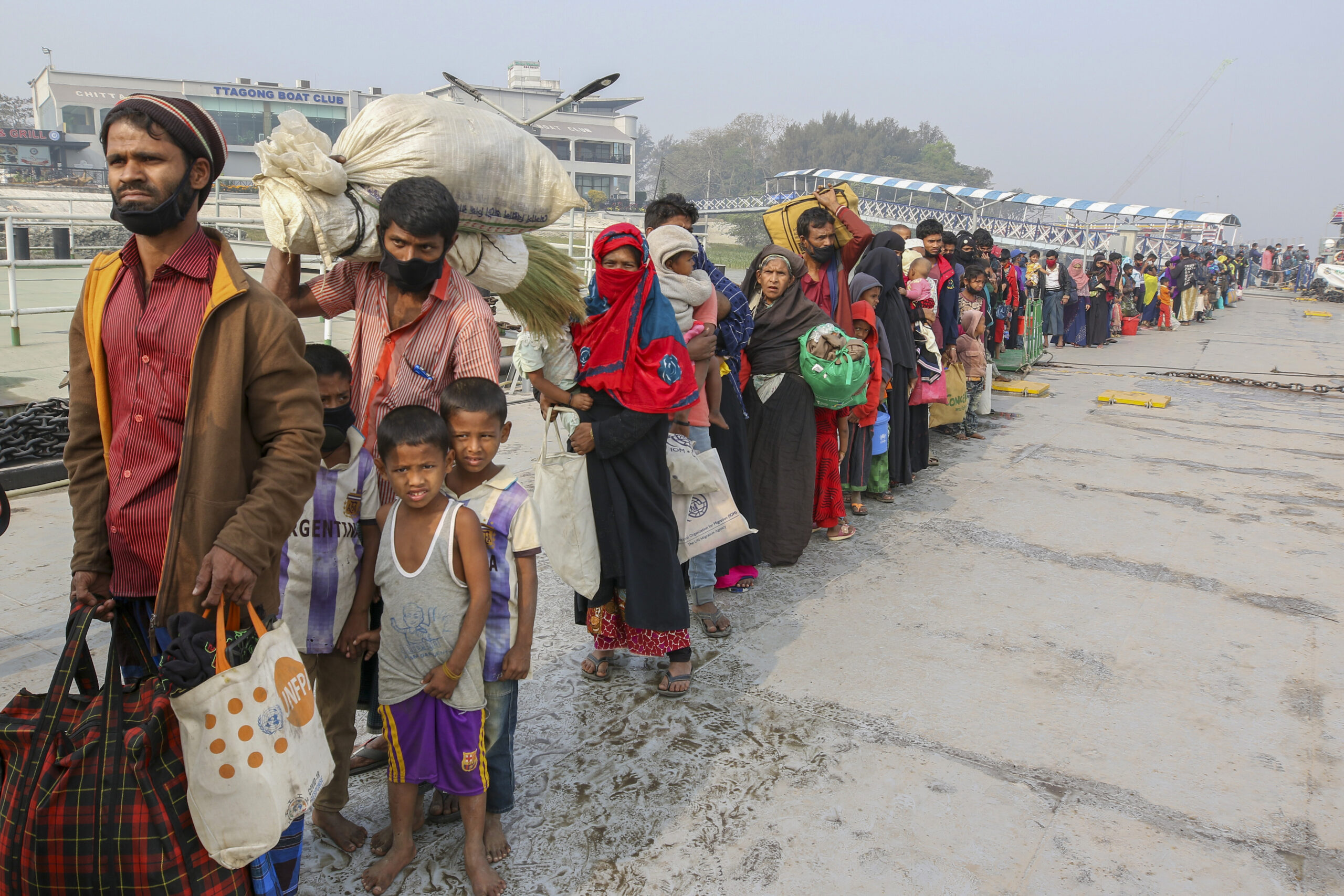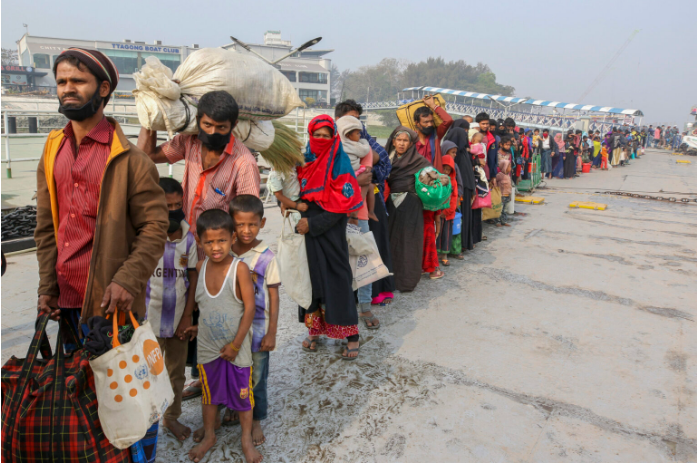
The Rohingya refugees have been subjected to violence for a long period of history and the Rohingya refugee crisis has become a global burning issue. The crisis should therefore be explained from a broader lens of geo-political and strategic game of power competition. Then, a few pertinent questions arise: What are the geopolitical and economic factors that have a decisive influence on Bangladesh’s Rohingya refugee crisis? Why does China support Myanmar’s position on the Rohingya refugee crisis? To what extent does the Rohingya refugee crisis impact the Belt and Road Initiative (BRI)? These questions merit rigorous academic analysis for gaining a better understanding and informed insights on the changing global and regional order.
Background:
With the rise of economic and military power of China, Professor Stephen Walt in his chapter contribution entitled, Rising Powers and the Risks of War: A Realist View of Sino-American Relations (2018) categorically predicted that the United States and China will increasingly see each other as rivals and will engage in more intense security competition.
In the 2017 “crackdown” in Rakhine, about 742,000 Rohingya people were driven out of Myanmar into neighboring Bangladesh, and about 6,700 Rohingya men, women, and children were massacred. There are about 931,000 registered Rohingya refugees living in the refugee camps of Ukhia and Teknaf upazilas in Cox’s Bazar, the world’s largest refugee settlement ( Figure 1).
Figure 1: Bangladesh: Rising violence, insecurity, and protection concerns in Cox’s Bazar refugee camps, ACAPS, Briefing note, 12 May 2023
China has enormous economic and geo-strategic interests in Myanmar’s Rakhine State. The Belt and Road Initiative (BRI) of China is a public policy strategy to advance the issues of globalization and regional interests. The rapid development and far-reaching impact of China’s economy during the past 30 years of the reforms and re-opening are unprecedented in world economic history. The rise of China is a global phenomenon.
The BRI of China has already attracted widespread attention from the academic and political worlds. The BRI intends to establish cooperation in five major directions: Trade and investment facilitation; policy coordination; infrastructure development and connectivity; financial coordination and integration; and people-to-people ties and connectivity. The BRI involves countries spanning Central Asia, South Asia, Southeast Asia and Oceania, Central and Eastern Europe, West Asia, and North Africa — over 900 projects, and close to $1 trillion as of mid-2018. China’s projected investment under the initiative ranges from $1.4tn to $6tn.
The Rohingya issue is one of the priorities of Xi Jinping’s government in China. Amid the Rohingya crisis, where about three quarters of a million people fled to Bangladesh following the military operation in Rakhine State in 2017, Beijing offered diplomatic protection to Naypyidaw in the face of international opposition.
Bangladesh’s security fears:
Sharing borders with Bangladesh, India, and China, Myanmar provides a gateway to the Indian Ocean. The influx of the Rohingya into the Bangladeshi borderland raises some serious concerns on our national security. As a host nation, Bangladesh faces a number of non-traditional security threats originating from the Rohingya crisis.
For instance, drug trafficking is a major threat to regional security and domestic stability. Illicit drugs have been seen as undermining national unity and, in extreme cases, as resulting in a failed state. Drug addiction has become a matter of serious societal concern.
Bangladesh is in close proximity to major drug-producing regions: The Golden Triangle and the Golden Crescent. Approximately 10.6 million people injected drugs worldwide in 2016, or 0.22% of the global population aged 15–64.
Some of the Rohingya are allegedly involved in the illicit drug trade due mainly to poverty, illiteracy, and vulnerability. Recent reports suggest that there is a marriage of convenience among the insurgent groups of the Chittagong Hill Tracts, human traffickers, and illicit drug dealers. Bangladesh has been used as a transit point for international drug traffickers.
Given that there are more than a dozen armed groups, including Myanmar’s Arakan Salvation Army (ARSA), are active in the refugee camps, and they are engaged in drug trading, kidnapping, infighting, extortion, and rapes, there are contrasting narratives about the situation of the Rohingya refugees in general and ARSA in particular. The situation is complex also from the fact that “radicalization of Rohingyas” has often been used by the Myanmar government and Tatmadaw (Myanmar’s military) to justify their atrocities against Rohingyas and then their refusal to taking the Forcibly Displaced Myanmar Nationals (FDMN) back to Myanmar. Barbara H. Sude’s chapter titled “Prevention of Radicalization to Terrorism in Refugee Camps and Asylum Centers” provides a comprehensive framework for understanding how refugees in camps and asylum centers are vulnerable to radicalization and how policymakers and humanitarian actors can intervene to prevent it. Applying this framework to the Rohingya refugee camps in Cox’s Bazar, Bangladesh, we can assess how the conditions and dynamics in these camps align with Sude’s analysis, and how her recommendations can be applied to mitigate the risks of radicalization among the Rohingya.
Applying Barbara H. Sude’s framework to the Rohingya refugee camps in Cox’s Bazar, it becomes clear that many of the risk factors she identifies—prolonged displacement, poor living conditions, trauma, statelessness, and extremist networks—are present. To prevent radicalization in the camps, Sude’s recommendations for improving living conditions, addressing grievances, providing mental health support, and engaging moderate religious leaders offer practical pathways for policymakers and humanitarian actors to pursue. Professor Shahab Enam Khan concluded his 2022 study with the following observations: “The political economy of religion further attests that there is an apparent, yet unexploited, demand for Rohingya to be recruited into Islamist and criminal groups. Statelessness identity can rise if the situation persists for a long time. For most certain, Islam shapes perception of the Rohingyas regarding their political aspirations, cultural value system, and socio-economic livelihood”. The radicalization of the Rohingyas in the Refugee camps is a matter of debate. It is true that the radicalization of the Rohingyas might hamper their repatriation.
When powers collide:
In recent years, both China and India have engaged with Bangladesh through various economic initiatives, loans, and investment offers, through which they both wish to secure their geopolitical interests in the country.
Accordingly, there has been intense conflict as well as cooperation between China and India. During the official visit of Chinese President Xi Jinping in October 2016, Beijing offered a package of $24 billion to Dhaka. To counter Beijing’s initiatives, the Indian government provided a $5bn line of credit and other economic assistance to Bangladesh during Prime Minister Sheikh Hasina’s visit to New Delhi in April 2017.
Moreover, the United States of America eyes to contain the rise of China. In international politics, there is a Machiavellian dictum, that is, enemy’s enemy is my friend. India and Pakistan, two nuclearized states in South Asia, are longstanding rivals or enemies.
Following the Machiavellian principle, China and Pakistan are proven to be time-tested allies and friends as well. China has a great deal of investments in Pakistan. For example, intense interest in the China–Pakistan Economic Corridor (CPEC) was stimulated when $46bn of investment agreements were signed in April 2015, a sum which two years later increased to $62bn.
A major focus of CPEC is on developing overland transportation and pipeline links from the port of Gwadar to the Chinese province of Xinjiang as a land-based alternative to the maritime “choke point” of the Straits of Malacca.
Geopolitics of the ‘Indo-Pacific’ Strategy:
Recent research suggests that China is setting up a separate economic zone and a deep seaport in Myanmar. The main objective of China is to establish authority in the whole Bay of Bengal. At the same time, the US and India operate to contain the Chinese influence and bilateral engagements with Bangladesh and Myanmar.
Resultantly, the United States uses the term “Indo-Pacific” as a rebalancing strategy towards Asia. However, there is no clear and coherent geographic definition of “Indo-Pacific.”
Indo-Pacific is originally a geographic concept that spans two regions of the Indian Ocean and the Pacific Ocean. Many US scholars view Chinese President Xi Jinping’s rise to power and growing Chinese assertiveness in the South and the East China Sea and the Indian Ocean region as the major underlying determinants behind the formulation of US Indo-Pacific strategy.
The Indo-Pacific region is also important for China from a geo-strategic and economic point of view. China has been pursuing its maritime ports building projects in Djibouti in the horn of Africa, Gwadar in Pakistan, Hambantota in Sri Lanka, and in the Maldives and Tanzania.
In pursuit of access to the Indian Ocean via the Bay of Bengal on the Myanmar side, China agreed in 2009 to construct a $1.5bn oil pipeline and $1.04bn gas pipeline between the port city of Kyaukpyu and Kunming in China. Thus, China’s energy diplomacy is an important element of the BRI strategy. Some Western and Indian analysts are worried about the “strings of pearls” strategy pursued under the Maritime Silk Road Initiative of China.
The ASEAN countries are very significant to China from the perspective of the BRI, because it aims to connect the country with Southeast Asia, South Asia, Central Asia, Russia, and Europe by land networks and Southeast Asia, South Asia, Oceania, and East African coastal regions via maritime trade routes.
China and India are also in a competitive race to get engaged in the economic and geo-strategic landscapes of Myanmar. Note that China has a historic claim to India’s northeastern border state of Arunachal. At the same time, Myanmar’s border regions are rich in natural resources such as oil and gas. For instance, Rakhine is a borderland province having large oil and natural gas reserves, reaching 11 trillion and 23 cubic feet respectively. India has, however, shifted from its “Look East” to “Act East” policy. The Look East Policy (LEP), which was launched in 1991 by the Narasimha Rao Government, was part of the development paradigm of the new economic reforms in India. The essence of India’s LEP was to build on the stagnant diplomatic and trade relations with the South-East Asian states, whereas the northeastern region was to facilitate as the gateway to these countries.
Global concerns
Last but not the least, the international community could arrive at the central realization that the presence of a large stateless population outside the country of origin can often lead to an internationalization of conflict, and consequently pose a threat to regional and global security. Chinese leaders and officials often propagate the concept of a Chinese dream — the dream of the Chinese national greatness with a voice in the global leadership position.
But the dream of the peaceful development of China with its large-scale BRI mega-project would remain merely “a dream” until and unless the Rohingya refugees-driven crucial issues on illiteracy, poverty, human rights violations, illicit drug trade, organized crime, human trafficking, violence, and underdevelopment are addressed properly and systematically.
Acknowledgement: An earlier version of this article was published in the Dhaka Tribune, October 26, 2022

